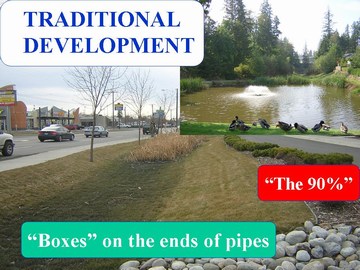Rainfall Capture & Infiltration: Why a 'Simplified Integrated Design Concept for Filters' is needed
Infiltration Systems are Filters
“We don’t commonly think of infiltration systems as filters. But they are,” wrote Dr. Gary Minton in 2008 when he set the stage for a 3-part series published by Stormwater Magazine .
“We have an underdrain system of soil rather than pipes. The filter media is the native soil. But it is becoming more common to specify engineered media (e.g., bioretention). Consequently, the distinction between the 'engineered filter' and 'nature’s filter' has blurred.”
“I have observed in manuals, articles, and reports, as well as in presentations and conversations at conferences, that the complexity of terminology itself leads to misperceptions and confusion over expected performance and to unnecessary and inappropriate distinctions in design procedures and criteria. This dynamic has led to inconsistencies in design procedures, often within the same manual.”
To Learn More
The 3-part series deals with rainwater/stormwater filters in the public domain. Dr. Minton's theme is simplification of terminology and consistency in design criteria. To read each article in the Stormwater Magazine series, click on the links below:
- Part 1: Terminology — Dr. Minton provides recommendations toward simplification, with the aim of achieving greater clarity. He notes that confusion over terminology and perceived differences where there are none has led to differing conclusions as to where to place a particular system in manuals.
- Part 2: Design Criteria Common to All Filter Types — Dr. Minton states that the objective is consistency in the sizing of filters and the design specifications for a particular filter type. He emphasizes that what is proposed is not that all manuals have the same design criteria but, rather, that the design criteria within the same manual be consistent.
- Part 3: Design Criteria Differing with Filter Types — “Let’s simplify our terminology by using names that more explicit: filter swale rather than dry swale; bioretention filter rather than bioretention. Let’s use consistent sizing procedures and design criteria for each filter type within a BMP manual,” summarizes Dr. Minton.
“Engineers do not necessarily realize these differences and potential conflicts because we work within our own community, state, or province with an agreed terminology and set of design criteria. However, as it becomes increasingly common to trade experiences and field results across regions and borders, contradictions and miscommunication are becoming more frequent. A common and simplified set of terminology and design procedures is warranted,” concludes Dr. Minton.
Acknowledgement:
Before STORMWATER, The Journal for Surface Water Quality Professionals, there was no single publication written specifically for the professional involved with surface water quality issues, protection, projects, and programs.
About Gary Minton
Dr. Gary Minton has been a leading contributor to the development of design criteria for rainwater/stormwater treatment relevant to the conditions of the Pacific Northwest. He is the author of the textbook Stormwater Treatment.
2007 Cross-Border Conference
In October 2007, Dr. Minton was a member of a cross-border panel at a joint Washington State/British Columbia conference held in Seattle. The panel compared an American top-down prescriptive approach versus a Canadian bottom-up educational approach.
The panel agreed on the need to tackle land use because that is where changes in hydrology are created. “We have a number of manuals in Washington State, but the design criteria don’t reflect what we have learned,” observed Dr. Minton.
Dr. Minton emphasized that US and Canadian stormwater manuals are not keeping pace with recent findings from field studies. He recommended several modifications to the design of common treatment BMPs like wet ponds and grass swales that improve performance, yet require no more and possibly less space than currently used.
“Considerable progress has been made in the acceptance of Low Impact Development concepts, which is heartening,” stated Dr. Minton, “However, we must not forget that LID whether of new developments or as retrofit will affect a relatively small percentage of development over the next few decades, perhaps on the order of 10%.”
“We therefore must not lose sight of the reality that the vast majority of new development will be traditional and that retrofitting will have a modest impact in the near future,” warned Dr. Minton.
To learn more, click on Rainwater Management on Diverging Paths in British Columbia and Washington State?

Posted March 2010

